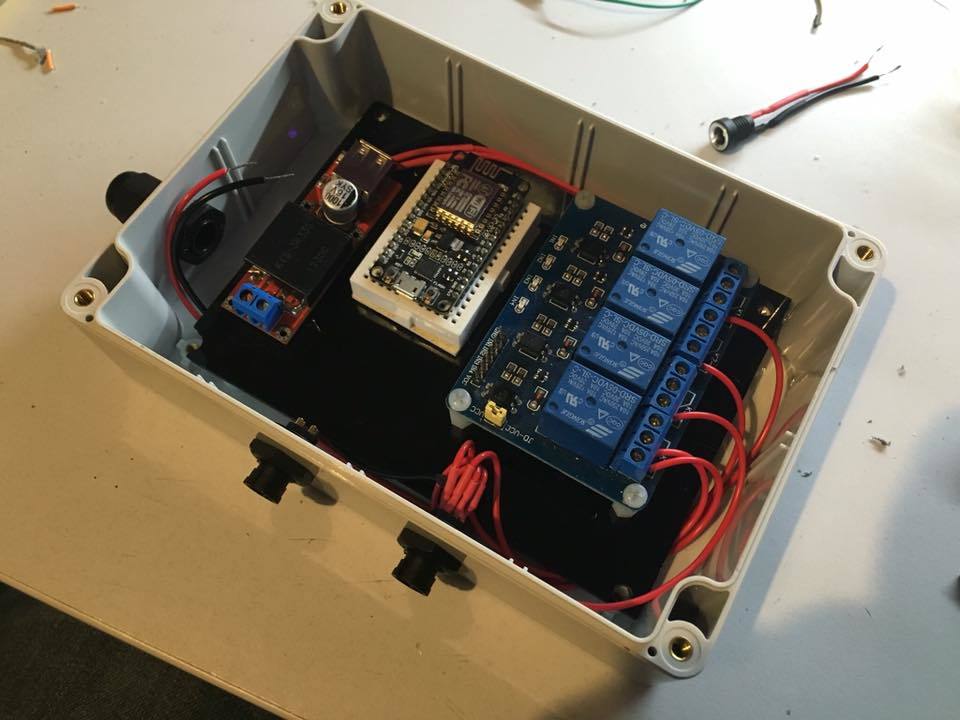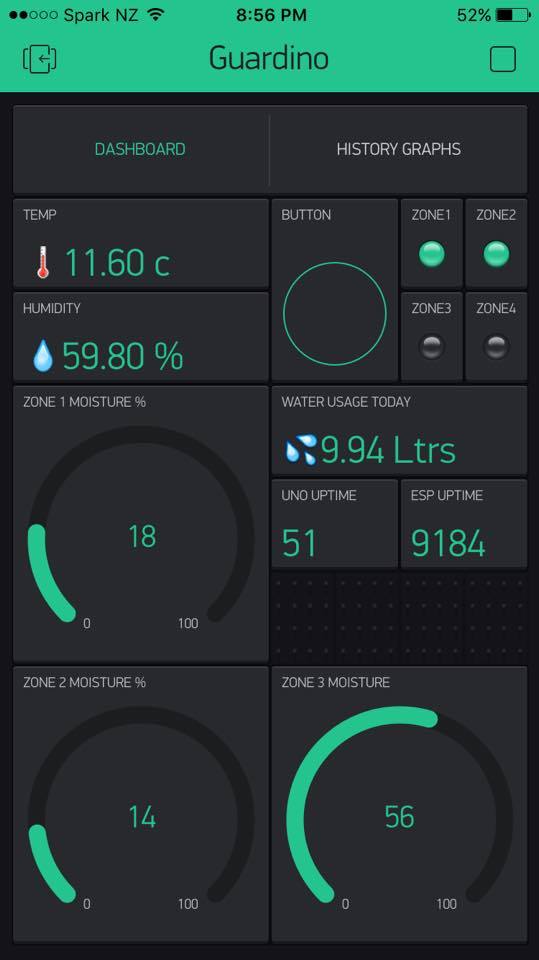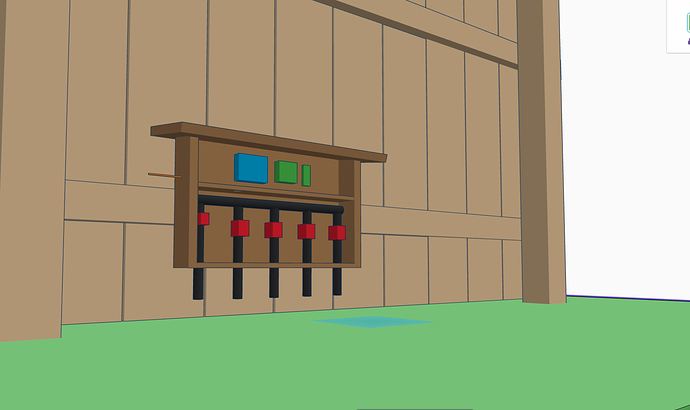Wow I LOVE that water solenoid distributor!! Did you make it youself?
I’m working on a similar system with only 4 valves. It’s a working work-in-progress.
I havn’t made any changes to it since August.
It’s made up of a brain and also solar powered sensors.
The brain and sensors all run on ESP8266 Dev boards (WeMos, NodeMCU etc).
The brain controls 4 solenoid valves by switching the power on and off via a relay bank.
Here is the code for the brain then the sensors. (the sensors are not finished for solar use but will give you the idea)
/*
Virtual Ports:
--------------
V0 = Terminal
V1 = RTC
V2 = Manual Mode Button
V3 = Wifi Signal (Value Widget)
V4 = Time (Value Widget)
V5 = Date (Value Widget)
V6 =
V7 =
V8 = Relay1 State LED
V9 = Relay2 State LED
V10 = Relay3 State LED
V11 =
V12 = Moisture Threshold
V13 = Moisture Reset
V14 = Moisture Threshold Display
V15 = Moisture Reset Display
V16 =
V17 = Daily Water Usage (Value)
V18 =
V19 =
V20 = Sensor: Zone 1 Moisture
V21 = Sensor: Zone 1 Wifi
V22 =
V23 = Sensor: Zone 2 Moisture
V24 = Sensor: Zone 2 Wifi
V25 =
V26 = Sensor: Zone 3 Moisture
V27 = Sensor: Zone 3 Wifi
V28 =
V29 =
V30 =
V31 =
*/
/****************************************************************************/
#define BLYNK_PRINT Serial // Comment this out to disable prints and save space
#include <ArduinoOTA.h>
#include <ESP8266WiFi.h>
#include <BlynkSimpleEsp8266.h>
#include <SimpleTimer.h>
#include <TimeLib.h>
#include <WidgetRTC.h>
/****************************************************************************/
char auth[] = "xxxxxxxx";
char ssid[] = "xxxxxxxxxx";
char pass[] = "xxxxxxxxxxx";
/****************************************************************************/
#define RELAY1 14 // D5
#define RELAY2 12 // D6
#define RELAY3 13 // D7
#define RELAY4 4 // D2
#define BLYNK_MSG_LIMIT 200
/****************************************************************************/
#define TERMINAL_vPIN 0
#define RTC_vPIN 1
#define MANUAL_MODE_vPIN 2
#define WIFI_vPIN 3
#define TIME_vPIN 4
#define DATE_vPIN 5
#define LED1_vPIN 8
#define LED2_vPIN 9
#define LED3_vPIN 10
#define MOIST_THRESHOLD_vPIN 12
#define MOIST_RESET_vPIN 13
#define MOIST_THRESHOLD_DISPLAY_vPIN 14
#define MOIST_RESET_DISPLAY_vPIN 15
#define DAILY_WATER_vPIN 17
#define MOIST_SENS1_vPIN 20
#define MOIST_SENS2_vPIN 23
#define MOIST_SENS3_vPIN 26
/****************************************************************************/
SimpleTimer timer;
SimpleTimer timer_relayStates;
SimpleTimer timer_getMoistureUpdates;
WidgetTerminal terminal(TERMINAL_vPIN);
WidgetRTC rtc;
BLYNK_ATTACH_WIDGET(rtc, RTC_vPIN);
/****************************************************************************/
String extraZeroH;
String extraZeroM;
String extraZeroS;
/****************************************************************************/
int manualMode;
int manualModePrev;
int moistureThreshold;
int moistureThreshold1;
int moistureThreshold2;
int moistureThreshold3;
int moistureThresholdReset1;
int moistureThresholdReset2;
int moistureThresholdReset3;
/****************************************************************************/
boolean RelayOneStatePrev;
boolean RelayTwoStatePrev;
boolean RelayThreeStatePrev;
boolean RelayFourStatePrev;
/****************************************************************************/
int moistureSensor1;
int moistureSensor2;
int moistureSensor3;
String signalStrength;
/****************************************************************************/
void sendUptime() {
extraZeroH = "";
extraZeroM = "";
extraZeroS = "";
if (hour() < 10) {
extraZeroH = '0';
}
if (minute() < 10) {
extraZeroM = '0';
}
if (second() < 10) {
extraZeroS = '0';
}
String currentTime = String(extraZeroH + hour()) + ':' + extraZeroM + minute() + ':' + extraZeroS + second();
String currentDate = String(day()) + '-' + monthShortStr(month()) + '-' + year();
Blynk.virtualWrite(DATE_vPIN, currentDate);
Blynk.virtualWrite(TIME_vPIN, currentTime);
signalStrength = map(WiFi.RSSI(), -125, -42, 0, 100);
signalStrength += '%';
Blynk.virtualWrite(WIFI_vPIN, signalStrength);
}
/****************************************************************************/
void sendRelayStates() {
if (RelayOneStatePrev != digitalRead(RELAY1)) {
Blynk.virtualWrite(LED1_vPIN, map(!digitalRead(RELAY1), 0, 1, 0, 255));
RelayOneStatePrev = digitalRead(RELAY1);
}
if (RelayTwoStatePrev != digitalRead(RELAY2)) {
Blynk.virtualWrite(LED2_vPIN, map(!digitalRead(RELAY2), 0, 1, 0, 255));
RelayTwoStatePrev = digitalRead(RELAY2);
}
if (RelayThreeStatePrev != digitalRead(RELAY3)) {
Blynk.virtualWrite(LED3_vPIN, map(!digitalRead(RELAY3), 0, 1, 0, 255));
RelayThreeStatePrev = digitalRead(RELAY3);
}
}
/****************************************************************************/
void getMoistureUpdates() {
Blynk.syncVirtual(MOIST_SENS1_vPIN);
//Blynk.syncVirtual(MOIST_SENS2_vPIN);
//Blynk.syncVirtual(MOIST_SENS3_vPIN);
}
/****************************************************************************/
BLYNK_CONNECTED() {
terminal.println("Reconnecting... Updating vPINs");
terminal.flush();
Blynk.syncVirtual(MANUAL_MODE_vPIN);
Blynk.syncVirtual(MOIST_THRESHOLD_vPIN);
Blynk.syncVirtual(MOIST_RESET_vPIN);
//Blynk.syncVirtual(MOIST_SENS1_vPIN);
//Blynk.syncVirtual(MOIST_SENS2_vPIN);
//Blynk.syncVirtual(MOIST_SENS3_vPIN);
}
BLYNK_WRITE(MANUAL_MODE_vPIN) {
manualOverride(param.asInt());
terminal.print("Manual Mode:");
terminal.println(param.asInt());
terminal.flush();
}
BLYNK_WRITE(MOIST_THRESHOLD_vPIN) {
moistureThreshold = param.asInt();
Blynk.virtualWrite(MOIST_THRESHOLD_DISPLAY_vPIN,param.asInt());
terminal.print("Moisture Threshold: ");
terminal.print(moistureThreshold);
terminal.println("%");
terminal.flush();
}
BLYNK_WRITE(MOIST_RESET_vPIN) {
moistureThresholdReset1 = param.asInt();
moistureThresholdReset2 = param.asInt();
moistureThresholdReset3 = param.asInt();
Blynk.virtualWrite(MOIST_RESET_DISPLAY_vPIN,param.asInt());
terminal.print("Moisture Reset: ");
terminal.print(param.asInt());
terminal.println("%");
terminal.flush();
}
BLYNK_WRITE(MOIST_SENS1_vPIN) {
if (!param.asInt()) {
moistureSensor1 = (int)999;
} else {
moistureSensor1 = param.asInt();
}
}
BLYNK_WRITE(MOIST_SENS2_vPIN) {
if (!param.asInt()) {
moistureSensor2 = (int)999;
} else {
moistureSensor2 = param.asInt();
}
}
BLYNK_WRITE(MOIST_SENS3_vPIN) {
if (!param.asInt()) {
moistureSensor3 = (int)999;
} else {
moistureSensor3 = param.asInt();
}
}
/****************************************************************************/
void setup() {
// PINMODS
pinMode(RELAY1, OUTPUT);
pinMode(RELAY2, OUTPUT);
pinMode(RELAY3, OUTPUT);
pinMode(RELAY4, OUTPUT);
// SET RELAYS OFF
digitalWrite(RELAY1, HIGH);
digitalWrite(RELAY2, HIGH);
digitalWrite(RELAY3, HIGH);
digitalWrite(RELAY4, HIGH);
// COMMS
Serial.begin(115200);
WiFi.mode(WIFI_STA);
Blynk.begin(auth, ssid, pass, IPAddress(192, 168, 1, 2));
while (Blynk.connect() == false) {}
ArduinoOTA.setHostname("gArduino-Base"); // OPTIONAL
ArduinoOTA.begin();
// RTC
rtc.begin();
// TIMERS
timer.setInterval(1000L, sendUptime);
timer_relayStates.setInterval(250L, sendRelayStates);
timer_getMoistureUpdates.setInterval(1000L, getMoistureUpdates);
// READY
terminal.println("### Garduino Base - Device started");
terminal.flush();
}
/****************************************************************************/
void manualOverride(int state) {
if (state == 1) {
digitalWrite(RELAY4, LOW);
digitalWrite(RELAY1, HIGH);
digitalWrite(RELAY2, HIGH);
digitalWrite(RELAY3, HIGH);
manualMode = 1;
} else if (state == 0) {
digitalWrite(RELAY4, HIGH);
manualMode = 0;
}
}
/****************************************************************************/
/****************************************************************************/
/****************************************************************************/
void loop() {
Blynk.run();
ArduinoOTA.handle();
timer.run();
timer_relayStates.run();
timer_getMoistureUpdates.run();
if (manualMode == 0) {
if (moistureSensor1 < moistureThreshold && digitalRead(RELAY1)) {
digitalWrite(RELAY1, LOW);
}
if (moistureSensor1 > moistureThresholdReset1 && !digitalRead(RELAY1) ) {
digitalWrite(RELAY1, HIGH);
}
if (moistureSensor2 < moistureThreshold && digitalRead(RELAY2)) {
digitalWrite(RELAY2, LOW);
}
if (moistureSensor2 > moistureThresholdReset2 && !digitalRead(RELAY2) ) {
digitalWrite(RELAY2, HIGH);
}
if (moistureSensor3 < moistureThreshold && digitalRead(RELAY3)) {
digitalWrite(RELAY3, LOW);
}
if (moistureSensor3 > moistureThresholdReset3 && !digitalRead(RELAY3) ) {
digitalWrite(RELAY3, HIGH);
}
}
}
/****************************************************************************/
Sensor Code:
/*
Virtual Ports:
V0 = Hue (Slider 0-255)
V1 = Saturation (Slider 0-255)
V2 = Brightness (Slider 0-255)
*/
/****************************************************************************/
#include <ArduinoOTA.h>
#include <ESP8266WiFi.h>
#include <BlynkSimpleEsp8266.h>
#include <SimpleTimer.h>
char auth[] = "xxxxxxxxx";
ADC_MODE(ADC_VCC);
SimpleTimer timer;
/****************************************************************************/
void setup()
{
WiFi.mode(WIFI_STA);
Blynk.begin(auth, "xxxxxxx", "xxxxxxxxxxx", IPAddress(192, 168, 1, 2));
while (Blynk.connect() == false) {}
/*********** OTA *************/
ArduinoOTA.setHostname("Tester-02-ESP8266");
ArduinoOTA.begin();
/******** READY **************/
timer.setInterval(1000L, sendUptime);
}
/****************************************************************************/
void sendUptime() {
Blynk.virtualWrite(1, millis() / 1000 );
Blynk.virtualWrite(2, map(WiFi.RSSI(), -105, -40, 0, 100) + String('%') );
Blynk.virtualWrite(3, ESP.getVcc() );
//Blynk.virtualWrite(4, analogRead(A0) );
}
/****************************************************************************/
void loop()
{
Blynk.run();
ArduinoOTA.handle();
timer.run();
}






 . That’s a neat workaround
. That’s a neat workaround 
